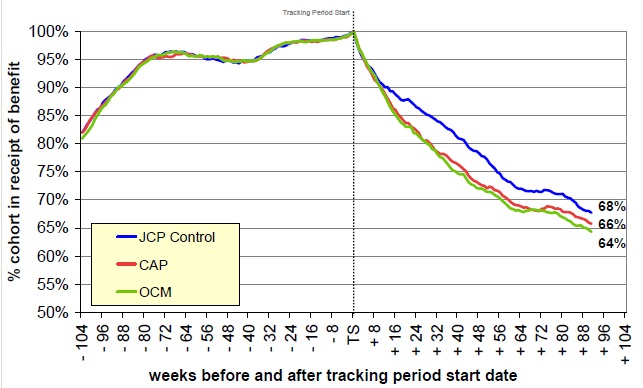The “Help to Work” pilots: success, failure or somewhere in between?
In a much-hyped announcement at Conservative Party Conference, George Osborne said that long-term unemployed people who, after 2 years on the Work Programme, were still on benefit would be obliged to undertake various forms of activity:
 Post Date
Post Date
 Reading Time
Reading Time
In a much-hyped announcement at Conservative Party Conference, George Osborne said that long-term unemployed people who, after 2 years on the Work Programme, were still on benefit would be obliged to undertake various forms of activity:
We are saying there is no option of doing nothing for your benefits, no something-for-nothing any more. They will do useful work to put something back into their community; making meals for the elderly, clearing up litter, working for a local charity. Others will be made to attend the job centre every working day. And for those with underlying problems, like drug addiction and illiteracy, there will be an intensive regime of support. No-one will be ignored or left without help. But no-one will get something for nothing.
Many people, including me,, were sceptical that it made sense to spend £300 million a year to put 200,000 people on a programme like this – named “Help to Work” – when the DWP’s own analysis of the existing evidence, both internationally and in the UK, suggests that such schemes are generally ineffective.
However, we now have some much more up-to-date information. The DWP, with remarkably little fanfare (not even a press release) published just before Christmas an assessment of the impact of the pilot for Help to Work, called the “Support for the Very-Long Term Unemployed Trailblazer”. (An earlier evaluation for DWP, by the National Centre for Social Research, was inconclusive on the actual impacts of the programme).
DWP describe the pilot as follows:
A 13 week pre treatment period to test deterrence, informing and maintaining awareness of forthcoming support throughout the period, and a 26 week period of treatment consisting of either intensive Jobcentre Plus support [“Ongoing Case Management”, OCM], contracted provider-led full time work experience or job search support [“Community Action Programme”, CAP], or a control option of standard Jobcentre Plus support.
This is essentially identical to the planned Help to Work Programme, except that instead of the control option participants will be required to attend Jobcentre Plus daily to sign on (a good briefing on Help to Work is here). So, for once, the government has actually piloted a programme before rolling it out; good for them. Even better, the pilot was a large-scale (over 15,000 participants) randomised control trial; we can be very confident that the results are robust. So what does the Help to Work pilot tell us about the likely impacts of Help to Work?
The good news: Help to Work reduced benefit receipt and (for OCM) increased employment among participants. The not so good news (but no surprise to those of us who know the literature): not by very much, and overall outcomes were still pretty bad. Nearly two years after the start of the programme, 68% of the control group were still on benefit; so were 66% of those doing community work, and 64% of those given intensive support, as this chart shows:

As for employment, 18% of those in the control group were recorded as having a job at the end of the tracking period (although there is likely to be some under-recording of part-time and low wage work for all groups); the figure was the same for those on CAP, and 1% higher for those on OCM. These differences were not statistically significant . However, over the whole period, participants in both CAP and OCM did spend (statistically) significantly more time in employment than the control group, but again the differences were very small (9 and 11 days respectively over the whole 2 year period). [NOTE; this section slightly corrected to note that employment outcomes at the end of the period were not significantly different from the control group. Thanks to Tom Wills of the Guardian datablog for pointing that out.]
2.jpg)
For comparison, the DWP evaluation of the Future Jobs Fund found that at a similar time horizon, the FJF reduced benefit claims by 7 percentage points and increased employment by about 11 percentage points.
There’s a lot more in the report (including the fact that, as with Mandatory Work Activity, obliging people to participate in these programmes raises the likelihood that they will claim Employment and Support Allowance). But for me the key conclusions are the following:
- it is important to give DWP credit for running a proper, randomised pilot and publishing the results;
- the bottom line – positive impacts, but small, and overall outcomes still very poor – is consistent with expectations and previous experience;
- the small impacts of the programme mostly reflect the fact that this is just a very difficult client group to help back into work, with many people facing severe and/or multiple barriers (the NatCen evaluation also brings this out). By comparison, the FJF client group was mostly people who had been unemployed for a considerably shorter period;
- The most encouraging result is that for OCM, which produced slightly better results than CAP. In other words, personalised support delivered by Jobcentre Plus advisors outperformed compulsory community work (“workfare”). We don’t have details on comparative costs, but I’d guess it was probably cheaper too;
- the results provide absolutely no support for the idea that a substantial proportion of the long-term unemployed are, as Iain Duncan Smith appears to believe, making a “lifestyle choice”, still less that they are working in the black economy or fraudulently claiming benefits. If they were, then one would think that being obliged to spend 6 months picking up litter, or similar, would sort them out and they would quickly leave benefits. But the peak benefit impact on those assigned to the CAP was just 5 percentage points, and almost 80 percent made it to the end of the programme;
- There is no cost-benefit analysis. But we know that Help to Work has an estimated cost per participant of £1,500. It seems unlikely the relatively modest impacts described above (the average participant spent about 3 weeks less on benefit over the tracking period) would cover this cost, either on an Exchequer cost or whole economy basis.
Finally, following on from this, and given that the government plans to spend £300 million a year on a programme essentially identical to this, producing a proper cost-benefit analysis should be a priority. Given the impact analysis has already been done, producing a CBA on the lines of that produced for FJF would be quick and relatively easy. If DWP doesn’t do it, then either the Work and Pensions Committee or the PAC should make them.

